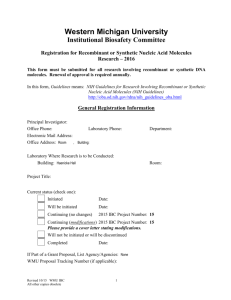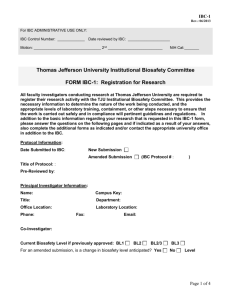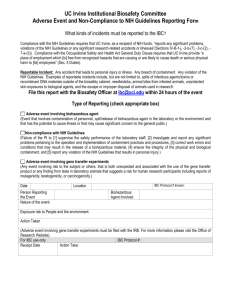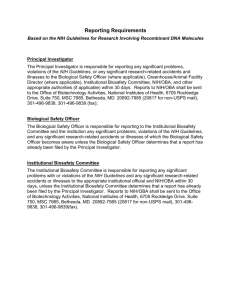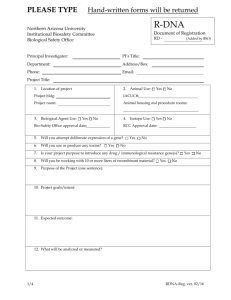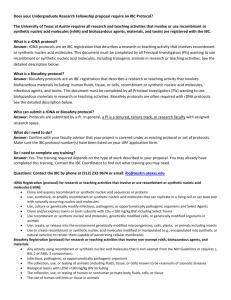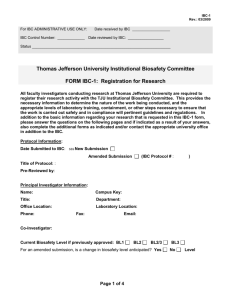Procedures for the Use of Recombinant or Synthetic Nucleic Acid
advertisement
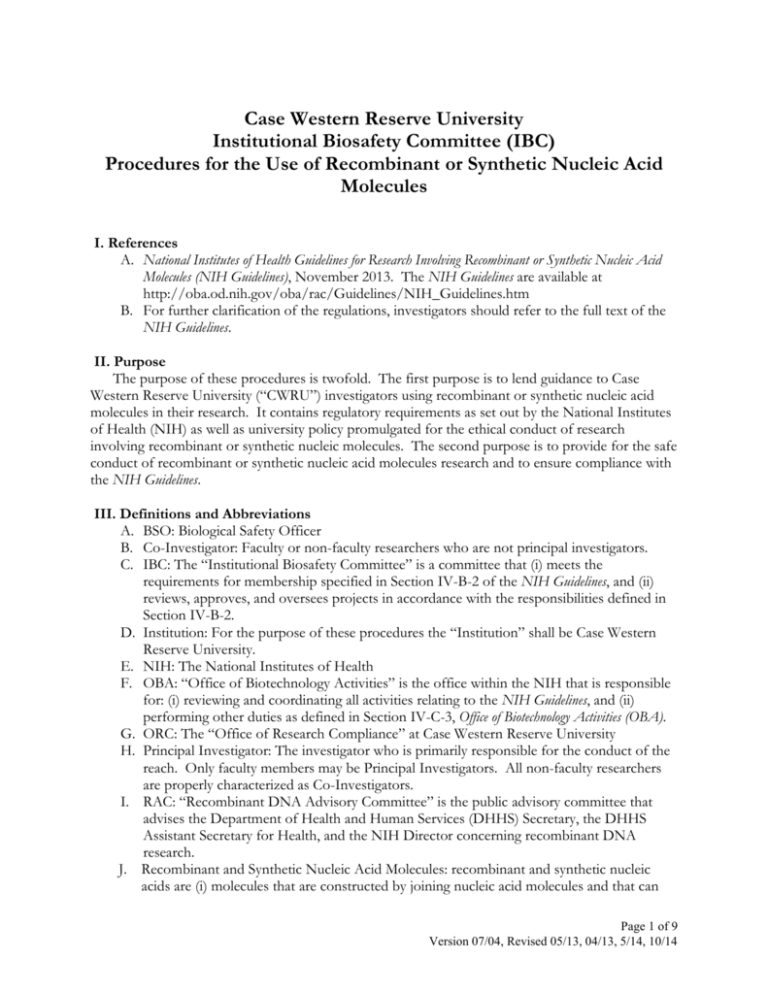
Case Western Reserve University Institutional Biosafety Committee (IBC) Procedures for the Use of Recombinant or Synthetic Nucleic Acid Molecules I. References A. National Institutes of Health Guidelines for Research Involving Recombinant or Synthetic Nucleic Acid Molecules (NIH Guidelines), November 2013. The NIH Guidelines are available at http://oba.od.nih.gov/oba/rac/Guidelines/NIH_Guidelines.htm B. For further clarification of the regulations, investigators should refer to the full text of the NIH Guidelines. II. Purpose The purpose of these procedures is twofold. The first purpose is to lend guidance to Case Western Reserve University (“CWRU”) investigators using recombinant or synthetic nucleic acid molecules in their research. It contains regulatory requirements as set out by the National Institutes of Health (NIH) as well as university policy promulgated for the ethical conduct of research involving recombinant or synthetic nucleic molecules. The second purpose is to provide for the safe conduct of recombinant or synthetic nucleic acid molecules research and to ensure compliance with the NIH Guidelines. III. Definitions and Abbreviations A. BSO: Biological Safety Officer B. Co-Investigator: Faculty or non-faculty researchers who are not principal investigators. C. IBC: The “Institutional Biosafety Committee” is a committee that (i) meets the requirements for membership specified in Section IV-B-2 of the NIH Guidelines, and (ii) reviews, approves, and oversees projects in accordance with the responsibilities defined in Section IV-B-2. D. Institution: For the purpose of these procedures the “Institution” shall be Case Western Reserve University. E. NIH: The National Institutes of Health F. OBA: “Office of Biotechnology Activities” is the office within the NIH that is responsible for: (i) reviewing and coordinating all activities relating to the NIH Guidelines, and (ii) performing other duties as defined in Section IV-C-3, Office of Biotechnology Activities (OBA). G. ORC: The “Office of Research Compliance” at Case Western Reserve University H. Principal Investigator: The investigator who is primarily responsible for the conduct of the reach. Only faculty members may be Principal Investigators. All non-faculty researchers are properly characterized as Co-Investigators. I. RAC: “Recombinant DNA Advisory Committee” is the public advisory committee that advises the Department of Health and Human Services (DHHS) Secretary, the DHHS Assistant Secretary for Health, and the NIH Director concerning recombinant DNA research. J. Recombinant and Synthetic Nucleic Acid Molecules: recombinant and synthetic nucleic acids are (i) molecules that are constructed by joining nucleic acid molecules and that can Page 1 of 9 Version 07/04, Revised 05/13, 04/13, 5/14, 10/14 replicate in a living cell (recombinant nucleic acids); (ii) nucleic acid molecules that are chemically or by other means synthesized or amplified, including those that are chemically or otherwise modified but can base pair with naturally occurring nucleic acid molecules (synthetic nucleic acids) or (iii) molecules that result from the replication of those described in (i) or (ii) above. IV. Policy Research involving recombinant and synthetic nucleic acid molecules conducted at or sponsored by CWRU, or research conducted by CWRU faculty members or students, must be conducted in a manner that does not pose a significant risk to (1) the health or safety of laboratory workers, others in the University community, or the public, or (2) the environment. Federal law on use of recombinant and synthetic nucleic acid molecules mandates the establishment of the IBC, which reviews, approves and oversees projects involving recombinant and synthetic nucleic acid molecules. A. All NIH-funded projects involving recombinant and synthetic nucleic acid molecules techniques must comply with the NIH Guidelines. Non-compliance may result in (i) suspension, limitation, or termination of financial assistance for the noncompliant NIHfunded research project and of NIH funds for recombinant and synthetic nucleic acid molecules research at the University, or (ii) a requirement for prior NIH approval of any or all recombinant DNA projects at the University. B. All non-NIH funded projects involving recombinant and synthetic nucleic acid molecules techniques conducted at or sponsored by the University that receives NIH funds for projects involving such techniques must comply with the NIH Guidelines. Noncompliance may result in (i) suspension, limitation, or termination of NIH funds for recombinant and synthetic nucleic acid molecules research at the University, or (ii) a requirement for prior NIH approval of any or all recombinant and synthetic nucleic acid molecules projects at the University. V. Organizational Structure and Responsibilities A. The University The University's duties include, but are not be limited to: 1. The responsibility for compliance with applicable regulations concerning recombinant and synthetic nucleic acid molecules used in research rests under the auspices of the Vice President for Research and Technology Management. The IBC shall serve as the immediate point of contact with Investigators to receive and review research projects proposing use of recombinant and synthetic nucleic acid molecules. 2. Establish and implement policies that provide for the safe conduct of recombinant and synthetic nucleic acid molecules research and that ensure compliance with the NIH Guidelines. Page 2 of 9 Version 07/04, Revised 05/13, 04/13, 5/14, 10/14 3. Appoint a Biological Safety Officer (who is also a member of the Institutional Biosafety Committee) if the institution: (i) conducts recombinant and synthetic nucleic acid molecules research at Biosafety Level (BL) 3 or (BL) 4, or (ii) engages in large scale (greater than 10 liters) research. The Biological Safety Officer carries out the duties specified in Section IVB-3. 4. Appoint at least one individual with expertise in plant, plant pathogen, or plant pest containment principles (who is a member of the Institutional Biosafety Committee) if the institution conducts recombinant and synthetic nucleic acid molecules research that requires Institutional Biosafety Committee approval in accordance with Appendix P, Physical and Biological Containment for Recombinant DNA Research Involving Plants. 5. Appoint at least one individual with expertise in animal containment principles (who is a member of the Institutional Biosafety Committee) if the institution conducts recombinant and synthetic nucleic acid molecules research that requires Institutional Biosafety Committee approval in accordance with Appendix Q, Physical and Biological Containment for Recombinant DNA Research Involving Animals. 6. When the University participates in or sponsors recombinant and synthetic nucleic acid molecules research involving human subjects, the University must ensure that (i) the Institutional Biosafety Committee has adequate expertise and training (using ad hoc consultants as deemed necessary), (ii) all aspects of Appendix M, Points to Consider in the Design and Submission of Protocols for the Transfer of Recombinant or Synthetic Nucleic Acid Molecules into One or More Human Subjects (Points to Consider), have been appropriately addressed by the Principal Investigator; and (iii) no research participant shall be enrolled (see definition of enrollment in Section I-E-7) in a human gene transfer experiment until the RAC review process has been completed (see Appendix M-I-B, RAC Review Requirements). 7. Assist and ensure compliance with the NIH Guidelines by Principal Investigators conducting research at the institution as specified in Section IV-B-4 of the NIH Guidelines. 8. Ensure appropriate training for the IBC Chair and members, Biological Safety Officer and other containment experts (when applicable), Principal Investigators, and laboratory staff regarding laboratory safety and implementation of the NIH Guidelines. The Institutional Biosafety Committee Chair is responsible for ensuring that Institutional Biosafety Committee members are appropriately trained. The Principal Investigator is responsible for ensuring that laboratory staff is appropriately trained. The institution is responsible for ensuring that the Principal Investigator has sufficient training; however, this responsibility may be delegated to the Institutional Biosafety Committee. 9. Establish an Institutional Biosafety Committee that meets the requirements set forth in Section IV-B-2-a of the NIH Guidelines and carries out the functions detailed in Section IVB-2-b of the NIH Guidelines. 10. Determine the necessity for health surveillance of personnel involved in connection with individual recombinant and synthetic nucleic acid molecules projects; and if appropriate, conduct a health surveillance program for such projects. Page 3 of 9 Version 07/04, Revised 05/13, 04/13, 5/14, 10/14 11. Report any significant problems, violations of the NIH Guidelines, or any significant researchrelated accidents and illnesses to NIH/OBA within thirty days, unless the institution determines that a report has already been filed by the Principal Investigator or Institutional Biosafety Committee. 12. Support the IBC in responding to requests for public comment (see below). B. The IBC The IBC's duties include, but are not be limited to: 1. In accordance with NIH Guidelines and University procedures, the IBC shall consist of no fewer than five members so selected that they collectively have experience and expertise in recombinant DNA technology and the capability to assess the safety of recombinant and synthetic nucleic acid molecules research and to identify any potential risk to the public health or the environment. The University shall follow the NIH Guidelines as necessary for the appointment of experts in certain fields of research. Those experts include (i) at least two (2) members not affiliated with the University and who represent the interest of the surrounding community with respect to health and protection of the environment, (ii) at least one individual with expertise in plant, plant pathogen, or plant pest containment principles when experiments utilizing Appendix P, Physical and Biological Containment for Recombinant or Synthetic Nucleic Acid Molecule Research Involving Plants, require prior approval by the IBC, (iii) at least one scientist with expertise in animal containment principles when experiments utilizing Appendix Q, Physical and Biological Containment for Recombinant DNA Research Involving Animals, require IBC prior approval, (iv) when the institution conducts recombinant DNA research at BL3, BL4, or Large Scale (greater than 10 liters), a Biological Safety Officer is mandatory and shall be a member of the Institutional Biosafety Committee (see Section IV-B-3, Biological Safety Officer). 2. No member of the IBC may be involved in the review or approval of a project in which he/she is, has been, or expects to be engaged or has a conflict of interest. 3. On behalf of the institution, the IBC is responsible for: a) Reviewing recombinant and synthetic nucleic acid molecules research conducted at or sponsored by the institution for compliance with the NIH Guidelines as specified in Section III, Experiments Covered by the NIH Guidelines, and approving those research projects that are found to conform to the NIH Guidelines. This review shall include: i. ii. iii. Independent assessment of the containment levels required by the NIH Guidelines for the proposed research; Assessment of the facilities, procedures, practices, and training and expertise of personnel involved in recombinant and synthetic nucleic acid molecules research; Ensuring that all aspects of Appendix M have been appropriately addressed by the Principal Investigator; Page 4 of 9 Version 07/04, Revised 05/13, 04/13, 5/14, 10/14 iv. v. vi. vii. Ensuring that no research participant is enrolled in a human gene transfer experiment until the RAC review process has been completed; For human gene transfer protocols selected for public RAC review and discussion, consideration of the issues raised and recommendations made as a result of this review and consideration of the Principal Investigator’s response to the RAC recommendations; Ensuring that final IBC approval is granted only after the RAC review process has been completed; and Ensuring compliance with all surveillance, data reporting, and adverse event reporting requirements set forth in the NIH Guidelines. b) Notifying the Principal Investigator of the results of the Institutional Biosafety Committee's review and approval; c) Lowering containment levels for certain experiments as specified in Section III-D-2a of the NIH Guidelines; d) Setting containment levels as specified in Sections III-D-4-b of the NIH Guidelines; e) Periodically reviewing recombinant and synthetic nucleic acid molecules research conducted at the institution to ensure compliance with the NIH Guidelines; f) Adopting emergency plans covering accidental spills and personnel contamination resulting from recombinant and synthetic nucleic acid molecules research; g) Reporting any significant problems with or violations of the NIH Guidelines and any significant research-related accidents or illnesses to the appropriate institutional official and NIH/OBA within 30 days, unless the IBC determines that a report has already been filed by the Principal Investigator; h) The IBC may not authorize initiation of experiments that are not explicitly covered by the NIH Guidelines until NIH (with the advice of the RAC when required) establishes the containment requirement; and i) Performing such other functions as may be delegated to the IBC under Section IVB-2, of the NIH Guidelines. 4. On behalf of the institution, the IBC will respond to requests for information from the public. a) The IBC will follow the NIH Guidelines for Research Involving Recombinant or Synthetic Nucleic Acid Molecules (NIH Guidelines) Section IV-B-2-a-(7) and upon request make available to the public the CWRU Institutional Biosafety Committee meeting minutes and any documents submitted to or received from funding agencies which the latter are required to make available to the public. If public comments are made on Institutional Biosafety Committee actions, the institution shall forward both the public comments and the Institutional Biosafety Committee's response to the Office of Biotechnology Activities, National Institutes of Health, 6705 Rockledge Drive, Suite 750, MSC 7985, Bethesda, MD 20892-7985 (20817 for non-USPS mail), 301496-9838, 301-496-9839 (fax). b) As noted under Section IV-B-2-a-(6), the CWRU Institutional Biosafety Committee has placed the information deemed proprietary under the heading “Confidential Discussion”. The CWRU IBC has a responsibility to protect the proprietary information of the investigators and Case Western Reserve University, included in Page 5 of 9 Version 07/04, Revised 05/13, 04/13, 5/14, 10/14 the protocols submitted to their committee. Therefore, the CWRU IBC has defined proprietary information to include but not be limited to the detailed step by step proposed experimental designs that have been planned but not published (which would also include the names of specific genes), and constructs that have not built or tested. Therefore, the information found considered under the heading or category of confidential discussion will be redacted from the CWRU IBC minutes before they are released to the public. C. Principal Investigator 1. Eligibility: Only faculty members are eligible to be Principal Investigators and submit applications to the IBC. All non-faculty researchers and students are properly characterized as Co-Investigators for purposes of conducting recombinant and synthetic nucleic acid molecules research sponsored by or conducted at the University. On behalf of the institution, the Principal Investigator is responsible for full compliance with the NIH Guidelines in the conduct of recombinant and synthetic nucleic acid molecules research. 2. General Responsibilities: As part of this general responsibility, the Principal Investigator shall: a. Initiate or modify no recombinant and synthetic nucleic acid molecules research which requires IBC approval prior to initiation until that research or the proposed modification thereof has been approved by the IBC and has met all other requirements of the NIH Guidelines; b. Determine whether experiments are covered by Section III-E, Experiments that Require Institutional Biosafety Committee Notice Simultaneous with Initiation, and ensure that the appropriate procedures are followed; c. Report any significant problems, violations of the NIH Guidelines, or any significant research-related accidents and illnesses to the Institutional Biosafety Committee, Biological Safety Officer (where applicable), Greenhouse/Animal Facility Director (where applicable) within 14 working days of discovery of the problem, violation or accident, and to NIH/OBA, and other appropriate authorities (if applicable) within 30 days of discovery of the problem, violation or accident. Reports to NIH/OBA shall be sent to the Office of Biotechnology Activities, National Institutes of Health, 6705 Rockledge Drive, Suite 750, MSC 7985, Bethesda, MD 20892-7985, (301)-4969838, (301)-496-9839 (fax). Reports to the IBC shall be sent to the Office of Research Compliance, Case Western Reserve University, ATTN: IBC, 10900 Euclid Avenue, Cleveland, Ohio 44106-7015, (216) 368-6925. d. Report immediately to the IBC and NIH/OBA spills and accidents which result in overt exposures to organisms containing recombinant or synthetic nucleic acid molecules. Reports to NIH/OBA shall be sent to the Office of Biotechnology Activities, National Institutes of Health, 6705 Rockledge Drive, Suite 750, MSC 7985, Bethesda, MD 20892-7985 (20817 for non-USPS mail), 301-496-9838, 301496-9839 (fax). Medical evaluation, surveillance, and treatment are provided as appropriate and written records are maintained. The CWRU IBC can be reached at (216) 368-6925. Page 6 of 9 Version 07/04, Revised 05/13, 04/13, 5/14, 10/14 e. Report any new information bearing on the NIH Guidelines to the IBC and to NIH/OBA; f. Be adequately trained in good microbiological techniques; g. Adhere to IBC approved emergency plans for handling accidental spills and personnel contamination; h. Comply with shipping requirements for recombinant and synthetic nucleic acid molecules; and i. Submit periodic summaries for review as requested by the IBC every three (3) years from the date of approval if the experiment is being conducted at Biosafety Level 1 or Biosafety Level 2. Investigators conducting experiments at Biosafety Level 3, Biosafety Level 4 or conducting experiments using human subjects, such as research involving gene therapy, shall submit periodic summaries on yearly basis from the date of approval. 3. Information to Be Submitted by the Principal Investigator to NIH/OBA The Principal Investigator shall: a. Submit information to NIH/OBA for certification of new host-vector systems; b. Petition NIH/OBA, with notice to the Institutional Biosafety Committee, for proposed exemptions to the NIH Guidelines; c. Petition NIH/OBA, with concurrence of the Institutional Biosafety Committee, for approval to conduct experiments specified in Sections III-A-1, Major Actions Under the NIH Guidelines, and III-B, Experiments that Require NIH/OBA and Institutional Biosafety Committee Approval Before Initiation; d. Petition NIH/OBA for determination of containment for experiments requiring case-by-case review; and e. Petition NIH/OBA for determination of containment for experiments not covered by the NIH Guidelines. f. Ensure that all aspects of Appendix M have been appropriately addressed prior to submission of human gene therapy experiments to NIH/OBA, and provide a letter signed by the Principal Investigator(s) on institutional letterhead acknowledging that the documentation being submitted to NIH OBA complies with the requirements set forth in Appendix M. 4. Submissions by the Principal Investigator to the IBC The Principal Investigator shall: a. Adhere to the IBC approved protocol and will promptly report proposed changes to the IBC. The proposed changes will not be initiated without IBC review and approval, except where necessary to eliminate apparent immediate hazards to investigators, staff, personnel, the environment or the public. Changes made to eliminate apparent immediate hazards must be reported to the IBC promptly. b. Make an initial determination of the required levels of physical and biological containment in accordance with the NIH Guidelines; c. Select appropriate microbiological practices and laboratory techniques to be used for the research; Page 7 of 9 Version 07/04, Revised 05/13, 04/13, 5/14, 10/14 d. Submit the initial research protocol and any subsequent changes (e.g., changes in the source of recombinant and synthetic nucleic acid molecules or host-vector system), if covered under Sections III-A, III-B, III-C, III-D, or III-E (Experiments Covered by the NIH Guidelines), to the Institutional Biosafety Committee for review and approval or disapproval; and e. Remain in communication with the Institutional Biosafety Committee throughout the conduct of the project. 5. Responsibilities of the Principal Investigator Prior to Initiating Research The Principal Investigator shall: a. Make available to all laboratory staff the protocols that describe the potential biohazards and the precautions to be taken; b. Instruct and train laboratory staff in: (i) the practices and techniques required to ensure safety, and (ii) the procedures for dealing with accidents; and c. Inform the laboratory staff of the reasons and provisions for any precautionary medical practices advised or requested (e.g., vaccinations or serum collection). 6. Responsibilities of the Principal Investigator During the Conduct of the Research The Principal Investigator shall: a. Supervise the safety performance of the laboratory staff to ensure that the required safety practices and techniques are employed; b. Investigate and report any significant problems pertaining to the operation and implementation of containment practices and procedures in writing to the Biological Safety Officer (where applicable), Greenhouse/Animal Facility Director (where applicable), Institutional Biosafety Committee, NIH/OBA, and other appropriate authorities (if applicable); c. Correct work errors and conditions that may result in the release of recombinant and synthetic nucleic acid molecules materials; and d. Ensure the integrity of the physical containment (e.g., biological safety cabinets) and the biological containment (e.g., purity and genotypic and phenotypic characteristics). e. Comply with reporting requirements for human gene transfer experiments conducted in compliance with the NIH Guidelines (see Appendix M-I-C, Reporting Requirements--Human Gene Transfer Protocols). f. All significant adverse events that occur during the course of a human clinical study registered with the IBC must be reported to the IBC. Study-related serious adverse events (SAEs) occurring within clinical research projects involving the introduction of recombinant or synthetic nucleic acid molecules into humans must be reported to NIH/OBA and the IBC within 15 calendar days of sponsor notification and within 7 calendar days if fatal or life threatening. Other SAEs should be reported to NIH/OBA and the IBC as part of the principal investigator’s annual report. The three alternative mechanisms for reporting serious adverse events to the NIH OBA are: by e-mail to oba@od.nih.gov; by fax to 301-496-9839; or by mail to the Office of Biotechnology Activities, National Institutes of Health, MSC 7985, 6705 Rockledge Drive, Suite 750, Bethesda, Maryland 20892-7985. Page 8 of 9 Version 07/04, Revised 05/13, 04/13, 5/14, 10/14 D. Biological Safety Officer The Biological Safety Officer's duties include, but are not be limited to: 1. Conducting periodic inspections to ensure that laboratory standards are rigorously followed; 2. Reporting to the Institutional Biosafety Committee and the institution any significant problems, violations of the NIH Guidelines, and any significant research-related accidents or illnesses of which the Biological Safety Officer becomes aware unless the Biological Safety Officer determines that a report has already been filed by the Principal Investigator; 3. Developing emergency plans for handling accidental spills and personnel contamination and investigating laboratory accidents involving recombinant and synthetic nucleic acid molecules research; 4. Providing advice on laboratory security; and 5. Providing technical advice to Principal Investigators and the Institutional Biosafety Committee on research safety procedures. Page 9 of 9 Version 07/04, Revised 05/13, 04/13, 5/14, 10/14


